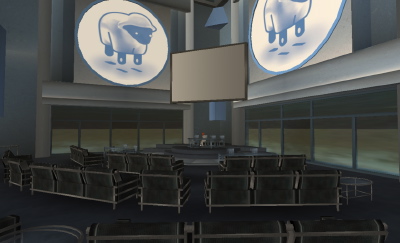Sorry, wrong virtual world
In the past two months, my own company lost three prospects to LL’s competition. Most of you would think they went to Blue Mars, because it enjoyed some hype as the future SL killer. It’s not so. Blue Mars hardly has any distinguishing feature for the corporate market, and, as you’ll soon see, they’re even worse off than LL on the choice of technology.
Since early 2008, a lot of opinion-makers were saying that the future would be web-based virtual worlds for kids; Lively was launched following the silly advice of those opinion-makers, and shut down half a year later; Metaverse held on for a little longer. Then opinion-makers suggested that corporations would require real information about real people to justify coming to a virtual world; LL slowly tried to switch everybody away from text and adopt voice and encouraged — through oppressive measures of identity validation — people to stop being pseudonymous. After the privacy fiascos of Facebook, and the examples given by Habbo Hotel vs. YoVille, apparently all these “theories” didn’t really make sense after all. Getting rid of privacy in SL seemed to be mostly a waste of effort, and LL reverted their decision regarding the extremely demanding validation measures; still, some claim that they’re too easy-going on alts and their potential for griefing.
The idea that big corps, government, and universities were shocked about casinos and sex in the virtual world seemed also to be another red herring. LL got rid of all that, or safely tucked them under the carpet out of sight. Big corps, government, and universities didn’t flock to SL enthusiastically. Today, they claim that the “bad image of SL as a sex-only VW” is too strong, and opinion makers nod their heads wisely. The harm is done and LL cannot fix it.
But no, the real reasons are actually quite simple, and very straightforward.
First of all, Second Life is incredibly expensive. Of course any Fortune 500 company can afford to buy a handful of sims, that goes without saying. But the point is that the competition is far more cheaper. OpenSim is free, you just have high maintenance costs — it’s not worth for a few sims, but if you require a vast virtual space, with hundreds or thousands of visually contiguous areas, OpenSim is extremely cost-effective. Oh, of course, you won’t be connected to SL and have no way to transfer content (legally) from SL to OpenSim. That doesn’t worry the corporations and the universities: the time when they pretended to have an interest in “community” or “readily-available” content is long gone. Now they have long-term projects, taking 3-5 years to develop (and not months or weeks like in 2006/7!) which are only for internal use. SL has little interest for them, and being disconnected from the SL Grid might even be seen as an advantage (less distraction!).
OpenSim, however, suffers from the same technical limitations as SL. Namely, it requires an ultra-heavy viewer. Of course, all average computers bought after 2007 will run SL decently fast. The problem is, these days, nobody seems to own an “average” computer any more! Cheap mini-laptops for US$300 abound — cheap is what sells during a financial crisis! — and almost none can run SL. Even a US$500 laptop, if not well chosen, won’t be powerful enough to run SL — or, if it does, it’ll run the battery flat in a couple of hours. Assuming, of course, that people have the patience to learn how to use it. Let’s face it, we residents are all very special people. We’re incredibly patient. When we logged in to SL for the first time, we spent countless hours learning the interface. That’s not an “average” user. The average user wants to spend 3 minutes registering for an account and expects everything to be immediately obvious after they log in; SL couldn’t be more distant from that goal. Even M Linden’s proposal to reduce the “first experience” to merely an hour is not ambitious enough. SL has to be as easy to use as Facebook (and even I get confused about Facebook’s menus often!).
And on top of that, SL works on top of proprietary communication protocols — which don’t go through corporate or campus firewalls. These days, network administrators leave users little choice through their firewalls but to connect to Web servers. Even Microsoft learned that the hard way and switched their Messenger protocol to run over HTTP — they became increasingly less popular as firewalls everywhere blocked their protocol as well. LL still sticks to their own protocols, in spite of some effort to the contrary (we’re still waiting for textures to be downloaded via HTTP!). From a developer’s point of view, it’s cool that we can, these days, communicate with objects in SL (and vice versa) — a strong selling point for SL as a platform to develop applications, because we’re not limited to LSL any longer. Well… you know what I mean. There are still huge limitations to LSL.
But SL’s IM protocol is perhaps the only one that is not moving to XMPP (made popular by Jabber, and famous by Google, although AIM and Yahoo are supposed to migrate to it too). And SL’s IM protocol is not only about IMs. Inventory transfers, money, group requests, and so forth, all go through that protocol — and it’s impossible to integrate it with existing platforms. Google Wave, for instance, to allow federation of Wave servers, just built everything on top of XMPP. You can’t do the same in SL — except by using ‘bots, and even that has limitations, since the ‘bot software, even though it had a few Lindens as contributors, is mostly a reverse-engineered effort. The standardisation process for the SL protocol is around the corner, but there will be several more months of waiting until that provides us with viable solutions.
Content, of course, is also completely proprietary. While the industry has kept a few standards around and provided tools to convert between them easily — VRML, Lightwave OBJ, COLLADA — SL has no standard for importing and exporting content, since it was supposed to be all done in-world anyway. All the other VW platforms — even simple ones like the now defunct Metaverse, but including Frenzoo, Moove, and many other small-scale VWs — support at least one of the standards. That means that content developers just create the content once, and tweak it and adapt it to any other platform. You can’t do that in SL. Well… until SL 2.1 is released at least. For now, however, it means that if you wish to create content in SL, you need to be proficient in the SL viewer, and that is another huge learning curve that few corporations or universities are willing to deal with. Add to that the notion that you aren’t supposed to make backups of your content — because LL does it for you — and you can imagine that the corporate and academic markets are not very happy about that. (We can’t even restore the content of a sim via the Estate Tools — we need to file a ticket with LL for that! — much less make a backup on our own disk…)
I’m aware that this is a question of IP rights vs. ease of development, but the point is, other platforms have no qualms about allowing developers to upload and make backups of their content.
So no wonder that companies and universities are jumping on the VW bandwagon — but not LL’s. They’re using Unity3D instead, which runs on Windows, Mac, iPhone/iPad, Android (soon), Wii… and on the Web, of course. The company behind Unity3D has very cleverly been able to infiltrate themselves into all markets by offering solutions that LL simply cannot provide. They tell prospective clients that they can get a rendering engine as good as LL’s (not so good as CryEngine3, but it runs on all platforms, not just on Windows — a big mistake Avatar Reality made when choosing a platform tied to a single operating system), use their own content, do application development using familiar languages and methodologies, and, well, put it on a CD or embed it on a Web page without the need to download anything.
How can LL compete with all that?
They used to have an advantage: “community”. But, as said, these days, corporations and universities couldn’t care less about “community”. They just want a cheap-to-develop VW fully under their control. SL couldn’t be further from that.





